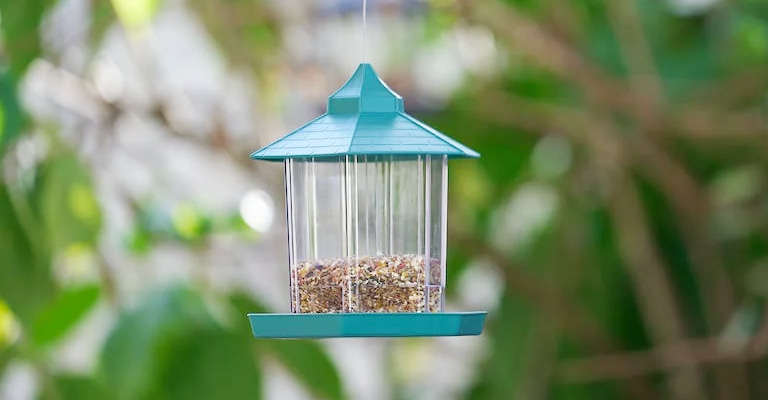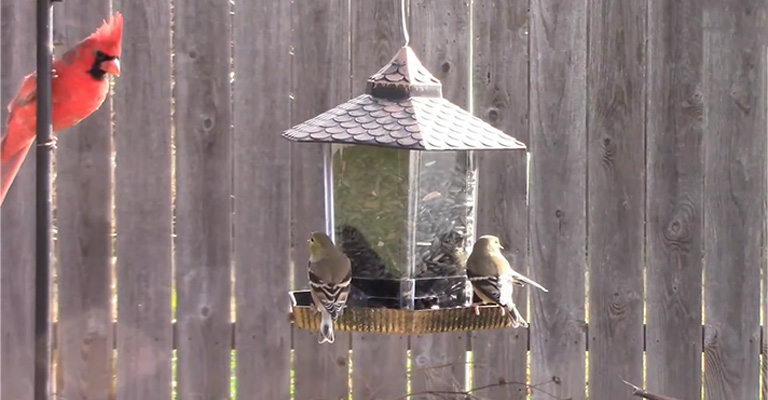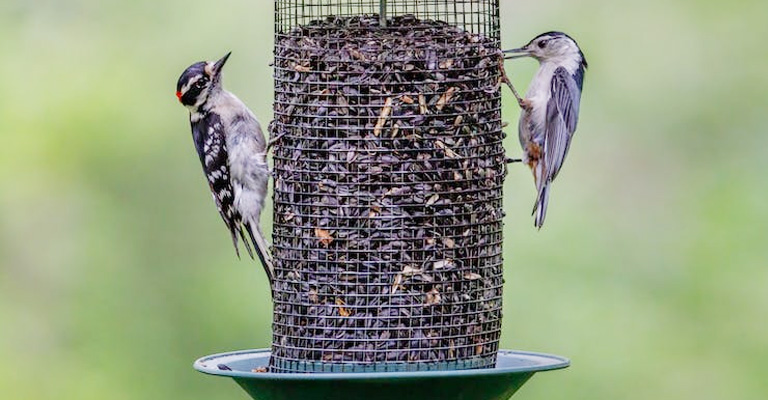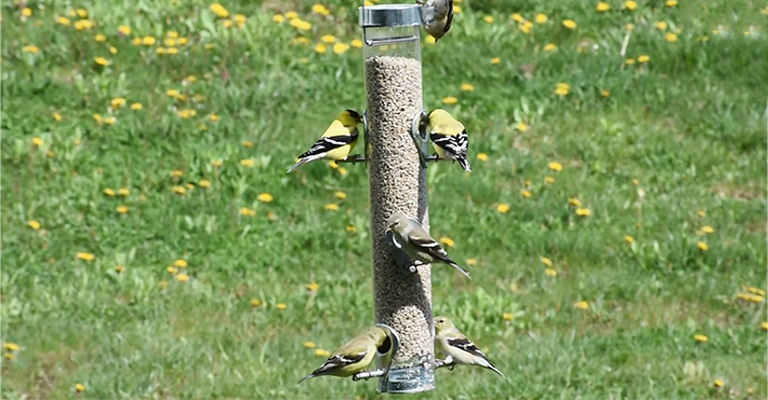The once lively scene of colorful feathers and melodious chirping around your bird feeder has suddenly turned into a desolate sight. The absence of our feathered friends can be disheartening, leaving us puzzled and wondering what could have caused this sudden exodus.
Birds are known to be regular visitors to feeders, providing us with a delightful display of nature’s beauty. However, when they stop coming, it raises questions about what might have changed in their environment or feeding habits.
Wondering ‘Why are birds not coming to my feeder anymore’? In this article, we will explore some common reasons why birds may have abandoned your feeder, shedding light on potential factors such as food availability, feeder placement, predator presence, and seasonal patterns.
By understanding these factors, we hope to help you attract these delightful creatures back to your feeder and restore the joy of birdwatching to your backyard.

Why Are Birds Not Coming to My Feeder Anymore?
The potential reasons why birds may have stopped visiting your feeder, shedding light on factors such as food quality, feeder cleanliness, predator presence, habitat changes, competition, weather conditions, seasonal patterns, disease outbreaks, and human interference. Let’s explore the details further.
Food Quality
Birds are selective eaters, and if the food you provide is stale, moldy, or of poor quality, they may seek alternative food sources. Ensure that the seeds, suet, or nectar you offer are fresh and free from contaminants.
Feeder Cleanliness
Dirty feeders can harbor bacteria, mold, and parasites, deterring birds from feeding. Regularly clean your feeder with mild detergent and hot water, and rinse thoroughly to maintain a hygienic feeding environment.
Predator Presence
The presence of predators, such as cats, squirrels, or larger birds, can create an unsafe environment for smaller feeder birds. Consider installing baffles or predator guards to protect the feeder and make it less accessible to potential threats.
Habitat Changes

Birds rely on suitable habitats for nesting, roosting, and foraging. Changes in the surrounding environment, such as the removal of trees or the introduction of new structures, may disrupt their natural patterns and discourage them from visiting your feeder.
Competition
If there are abundant natural food sources available, birds may prefer those over the offerings at your feeder. Assess the availability of natural food in your area and adjust your feeder offerings accordingly to attract birds.
Weather Conditions
Extreme weather events, such as storms, heavy rainfall, or prolonged droughts, can impact bird behavior and their feeding patterns. Birds may temporarily seek shelter or find alternative food sources during such conditions.
Seasonal Patterns
Bird populations fluctuate throughout the year due to migration, breeding, and natural cycles. It is common for certain species to be less frequent visitors during specific seasons. Research the migratory patterns of local bird species to understand their seasonal presence.
Disease Outbreaks
Birds can be susceptible to various diseases, such as avian pox or salmonellosis. If there is a disease outbreak in the area, birds may avoid feeders to minimize the risk of transmission. Maintain good hygiene practices and monitor local bird health advisories.
Human Interference
Excessive noise, sudden movements, or the presence of humans near the feeder can startle and disturb birds. Ensure that your feeder is placed in a quiet and undisturbed location to provide a calm and safe feeding environment.
Tips to Attract Birds to Your Bird Feeder

Attracting birds to your bird feeder can be a rewarding experience. Here are some tips to help you create an inviting environment that will entice birds to visit your feeder:
Choose the Right Feeder
Select a feeder that is suitable for the types of birds you want to attract. Different species have different feeding preferences, so consider feeders with specific designs such as tube feeders, platform feeders, or suet feeders.
Offer a Variety of Foods
Provide a diverse range of bird-friendly foods to cater to different species. Common options include sunflower seeds, nyjer seeds, millet, suet, and nectar. Experiment with different food combinations to attract a wider variety of birds.
Keep the Feeder Clean
Regularly clean your feeder to prevent the buildup of mold, bacteria, and parasites. Use a mild detergent and hot water to wash the feeder, and rinse it thoroughly before refilling. A clean feeder ensures the health and safety of visiting birds.
Provide Fresh Water
Birds need water for drinking and bathing. Place a shallow birdbath near the feeder and keep it filled with fresh water. Consider adding a small fountain or dripper to attract birds with the sound of running water.
Create a Safe Environment
Birds are more likely to visit feeders in areas where they feel safe. Position your feeder near trees or shrubs that provide cover and perching spots. Avoid placing the feeder too close to windows or areas where predators can easily access it.
Plant Native Plants
Native plants provide natural food sources, shelter, and nesting sites for birds. Incorporate a variety of native flowers, shrubs, and trees in your yard to attract birds and create a bird-friendly habitat.
Offer Shelter and Nesting Sites
Install birdhouses, nesting boxes, or natural materials like twigs and leaves to provide shelter and nesting opportunities for birds. Different species have specific preferences, so research the requirements of the birds in your area.
Be Patient and Consistent
It may take time for birds to discover and trust your feeder. Be patient and maintain a consistent feeding routine. Once birds find a reliable food source, they are more likely to return regularly.
Minimize Disturbances
Avoid sudden movements, loud noises, or excessive human activity near the feeder. Birds are sensitive to disturbances and may be hesitant to visit if they feel threatened. Create a calm and quiet environment to encourage their presence.
Consider Seasonal Offerings
Different seasons bring changes in bird behavior and dietary needs. Research the seasonal preferences of birds in your area and adjust your feeder offerings accordingly. For example, during migration, offer high-energy foods to attract traveling birds.
By implementing these tips, you can create an attractive and welcoming environment that will entice birds to visit your feeder. Enjoy the beauty and wonder of these feathered visitors as they bring life and joy to your backyard.
Which Bird Feeders Attract Most Birds?

Different bird feeders attract different types of birds, but there are a few types of feeders that tend to attract a wide variety of bird species. Here are some bird feeders that are known to attract a diverse range of birds:
Tube Feeders
Tube feeders with multiple feeding ports and perches are popular among many bird species. They can accommodate various types of seeds, such as sunflower seeds, nyjer seeds, or mixed seeds, which appeal to a wide range of birds.
Platform Feeders
Platform feeders provide a flat surface for birds to perch on while feeding. They are suitable for offering a variety of foods, including seeds, nuts, fruits, and suet. Many ground-feeding birds, such as sparrows, juncos, and doves, are attracted to platform feeders.
Hopper Feeders
Hopper feeders have a container that holds a large amount of bird food, which is dispensed gradually as birds feed.
They are versatile and can accommodate different types of seeds, attracting a variety of bird species, including finches, cardinals, chickadees, and titmice.
Suet Feeders
Suet feeders are designed to hold blocks or cakes of suet, a high-energy food made from animal fat. They are particularly attractive to insect-eating birds, such as woodpeckers, nuthatches, and chickadees. Suet feeders often have wire mesh or cages to hold the suet securely.
Hummingbird Feeders
Hummingbird feeders are specifically designed to attract these small, nectar-loving birds. They typically have red or brightly colored parts to catch the attention of hummingbirds. Fill them with a homemade or store-bought nectar solution to entice these fascinating birds.
Nyjer Feeders
Nyjer feeders, also known as thistle feeders, are designed to hold tiny Nyjer seeds. These feeders are particularly attractive to finches, including goldfinches, siskins, and redpolls. The small ports on Nyjer feeders prevent larger birds from accessing the seeds.
Remember, the type of birds you attract will also depend on the region you live in and the specific bird species that are native to your area.
It’s a good idea to research the local bird species and their feeding preferences to choose the most suitable feeders for your backyard.
Additionally, offering a variety of feeders and food types will increase the chances of attracting a diverse range of bird species to your yard.
FAQs
The frequency of refilling your bird feeder depends on the number of birds visiting and the capacity of the feeder. As a general guideline, check your feeder daily and refill it when it is about three-quarters empty.
Squirrels can be persistent in their attempts to access bird feeders. To deter them, consider using squirrel-proof feeders with mechanisms that prevent them from reaching the food.
You can also place baffles or guards on poles or hanging wires to make it difficult for squirrels to climb.
Yes, providing water alongside your bird feeder is beneficial for birds. Birds need water for drinking and bathing, especially during hot and dry periods. Place a shallow birdbath near the feeder and keep it filled with fresh water.
It is generally not recommended to feed birds bread or leftovers from your kitchen. Bread lacks the necessary nutrients for birds and can fill them up without providing proper nutrition.
Leftovers may contain seasonings, oils, or ingredients that are harmful to birds.
To attract specific bird species to your feeder, research their feeding preferences and habitat requirements. Provide the specific foods they prefer, such as nyjer seeds for finches or suet for woodpeckers.
Final Words
While the sudden absence of birds at your feeder may be disheartening, it is important to remember that there are several factors that could contribute to their departure.
By examining potential causes such as food availability, feeder placement, predator presence, and seasonal patterns, you can take proactive steps to address the issue and entice the birds back to your feeder.
Consider offering a variety of bird-friendly foods, ensuring your feeder is clean and accessible, and implementing measures to deter predators.
Additionally, be mindful of the natural fluctuations in bird populations that occur throughout the year.
Patience and persistence are key when it comes to attracting birds to your feeder. By making the necessary adjustments and creating a welcoming environment, you can once again enjoy the delightful presence of our feathered friends and continue to marvel at the wonders of nature in your own backyard.